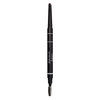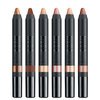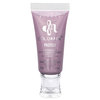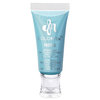All About Brushes: Natural Hair Brushes
5

Our customer service team in the US is ready to assist you.
Monday - Friday
7 AM – 4 PM PT
Saturday
7 AM – 4 PM PT



Sisley-Paris Phyto-Sourcils Design 3-in-1 Architect Pencil 5 Taupe
$75

Sisley-Paris Phyto-Sourcils Design 3-in-1 Architect Pencil 6 Espresso
$75

Nudestix Nude Beach 6-Piece Eye Pencil Palette
$69

Danessa Myricks Beauty ColorFix 24-Hour Cream Color Matte Sundaze
$20

Danessa Myricks Beauty ColorFix 24-Hour Cream Color Matte Oasis
$20
Please help us maintain positive conversations here by following our guidelines below.
We reserve the right to remove comments and topics that don't adhere to the following rules. We also may remove the profile of any repeat offender. Thanks for reading and contributing!
Beautylish is a diverse, positive, and respectful community. It’s okay to disagree with someone, but be constructive—not rude. We have a zero-tolerance policy for negativity and harassment.
Take the time to make posts easy to understand by using proper spelling, grammar, and capitalization. Post topics in the appropriate category and refrain from making duplicate posts. Know that we don't allow self-promotion, advertisements, spam, commercial messages, or links to other websites or blogs. And be careful that you don't post someone else's work and present or claim it as your own.
We reserve the right to remove duplicate, miscategorized, and difficult-to-understand posts, or those we deem as advertisements, spam, or plagiarism.
Use the flag button to report inappropriate or disrespectful behavior, or email us at help@beautylish.com.
Mar 20, 2011
Krystal C.
I have been using makeup brushes for years, and I still find myself researching information about them online. I knew that popular makeup companies provided brushes made of goat hair and sable, but I had no idea that there were other animal hairs incorporated in those brushes or just used on their own. Each hair type has a different feel and performance, and when some of them are mixed together in a brush, you have a high quality brush that multitasks and can cost a pretty penny. I thought it would be informative to provide information on the types and quality of the different hairs for people who are just getting into using cosmetic brushes or people who use them daily but don't know much about them. I hope you enjoy this, it was very interesting to familiarize myself with the look and quality of the hairs I see in my makeup brush collection.
Squirrel
Texture: Very fine, thin
Squirrel hair is taken from the tail of the brown squirrel (Kazan) to make quality lining brushes. Squirrel points as well as Kolinsky, but it has very little “snap” and is much less resilient. Squirrel works best with liquid and cream makeup. Squirrel hair brushes have thick "bodies" to hold product, but they lack the "snap" or springiness of a Kolinsky.
Goat
Texture: Soft, strong
Wide usage for make-up applications due to its softness and strength. Goat hair is the most commonly used hair type in making cosmetic brushes as they are the least costly to make as the hair is widely available. The softest goat hair is the first-cut with the tips still intact. Lower-cut (blunt-cut) are used in the manufacture of mass produced (not hand made) lower quality cosmetic. The top quality goat hair type makeup brush range, is hand-made like any other high quality cosmetic brush to preserve their precious tips.
Badger
Texture: Stiff, long, bushy
High Quality Badger hair (referred to as Badger 'Tapers') is similar to squirrel, kolinsky sable, weasel or red sable, in that Water Badger Hair 'tapers', hence it also has a 'conical' shape. This means that high quality badger hair makeup brushes would also have thick bellies and thin pointy tips. Badger brushes comes from various parts of the world and is more readily available than most animal hair, although the quality varies greatly. Badger hair is thickest at the point, and relatively thin at the root, so it has a distinctive "bushy" appearance. The top grade is very soft and makes is excellent for blending.
Kolinsky Sable
Texture: Fine, soft, long
Derived from the tail of the mink, sable is the best cosmetics bristle: Its strength, spring, and snap are unsurpassed, and the hair comes to a very fine point. With proper care, Kolinsky Sable brushes will last many years. Kolinskies have a 'spring' resilience. Most Kolinsky brushes are made with a 60% female to 40% male mixture. The best brushes will spring or snap back straight after bending, while the brushes made of mixtures will hold a slight bend.
Pony
Texture: Soft and slightly coarse, strong, cylindrical, fine, resilient, absorbent. Derived from an animal that is at least two years old. The finest pony hair comes from the belly, and fine hair comes from the mane of the animal; and this is often blended with lesser-grade hairs for economical touch-up brushes. Pony hair is usually cylindrical in shape, this means that pony hair has little or no 'belly' and has less 'pointy' tips compared to squirrel hair or kolinsky sable. Pony hair makeup brush is less expensive than squirrels but more expensive than goat hair to make. Pony hair doesn't hold its shape well. It is used as a filler to reduce the price of a brush.
Raccoon
Texture: Soft, bendable
Grayish, brown tail hair from mammal found in North America. It has excellent springback. The double toned hair is generally used for high-grade make-up brushes.
Pahmi
Texture: Soft, strong
Good for make up applications . Soft hair with ideal strength. Used in premium brushes. makeup brushes are made from a weasel-like animal but smaller and thinner. The hair is slightly stiffer and the tip is short. It is often used as a filler in other brushes.
Camel
Texture: Soft, durable
Camel hair is actually an industry term, coined after Mr. Camel, who invented the brushes: It includes the finer grades of squirrel hair, and other grades like pony and goat hair. Actual camel hair is too woolly for brushes and they range greatly in softness, quality and cost. These soft-haired brushes are made of pony, ox, goat or other inexpensive hair, or a mixture. Camel hair is also used for filler in other pure hair brushes.
Photos, additional information and links to website where this information was gathered can be found on my blog: http://beautybykrystalc.blogspot.com/2011/03/all-about-brushes-natural-hair-brushes.html?showComment=1300638613003#c4379770815351812081
Mar 21, 2011
Soma S.
What a great break-down of brush hair types! Thank you for explaining so well! =)
Mar 21, 2011
Krystal C.
Thank you - I did a lot of research and tried to compile it all into a legible form! :)
Mar 21, 2011
Amanda K.
thanks for the info! now what brushes are made of what and where ;) he he
Mar 22, 2011
Krystal C.
I usually see brushes in person to understand if I like how they feel, then go home and research on the brand's website the hairs they use. Usually people in the cosmetic stores/counters don't know what the brushes are made of. I normally buy my brushes online.